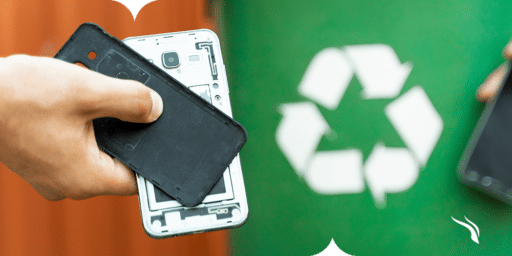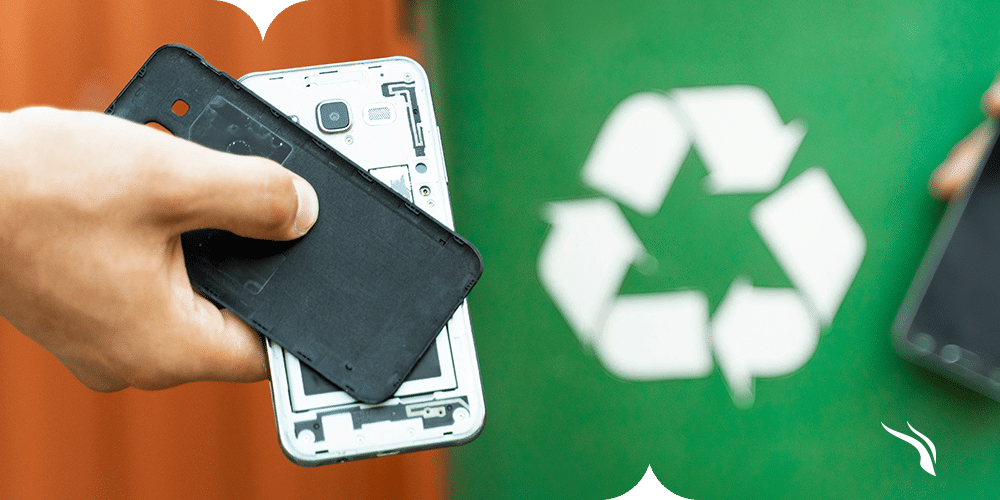The new iPhone 16 has impressed tech enthusiasts since it launched, but buying it leaves you with the question of what to do with your old phone. If you want to recycle an old phone properly to help the environment, local resources like the NYS Department of Environmental Conservation can point you in the right direction.
People also get creative, recycling their old phones into a new role; you might use them exclusively for playing music or use various apps to turn your device into a security camera.
However, the best option is often the simplest one. By selling your old phone, you can keep it out of a landfill and contribute to the cost of buying a new phone.
1. Clean Your Phone
When you trade in your cell phone, aim to return it in the best condition possible. Here’s what you’ll need to achieve a thorough, nearly new cleaning:
- Rubbing alcohol to clean your keypad and plastic.
- Avoid window cleaners, aerosol sprays, or anything with ammonia in it. These chemicals are more likely to damage your phone than clean it. Also, don’t allow cleaning liquid to seep into the headphone jack or charging point.
- Microfiber cloth (soft and lint-free).
- Cotton swabs.
Apply a small amount of liquid to the microfiber cloth and gently clean the screen and casing, using cotton swabs for harder-to-reach areas.
2. Back up Your Phone
The idea is to ensure you have backed up all of your data in one secure location. Then, when you sell or trade-in your phone, your data can be easily transferred to your new device.
With an iPhone, tap Settings, then iCloud, and then choose Storage & Backup. Enable the iCloud Backup feature, then select Back Up Now to move your data to the cloud.
If you have an Android phone, it’s a little more involved, but not to worry. For starters, Google Sync backs up most of your data for you – all you have to do is go to your Settings menu and select Accounts and Sync.
You can also back up your data the old-fashioned way: by using the USB cable to connect your Android phone to a computer and then copying all your files.
If you own an Android 5 or 6.0 Marshmallow phone, you are among the chosen few. Those phones back up everything without you having to lift a finger.
3. Conduct Factory Reset
If you’re trading in your phone (say, for the new iPhone 7), the main thing is to ensure your personal information doesn’t fall into the wrong person’s hands.
A factory reset gives your phone a clean slate by wiping its data and returning it to its condition when you first bought it.
It’s pretty easy with an iPhone. Go to the Settings menu, tap General, select Reset, and then Erase All Content. With an Android phone, conduct a factory reset by tapping Menu, then selecting Settings, Privacy, and Factory Data Reset. To remove all data, press Reset Phone.
- Select Apps > Settings (NOT Google Settings) > Backup & reset > Factory data reset > Reset phone > Erase everything
4. Encrypt Your Data
After you reset your phone, you’re not done. Reset will remove a good chunk of your data, but if you have an Android phone, beware: A full factory reset may not eliminate your email addresses, texts, and even selfies! This is why it’s essential that you encrypt your data before wiping it. When you encrypt your phone, everything becomes scrambled, making your data unreadable. With iPhones, encryption occurs naturally; with some Android phones, you have to do it manually via the settings menu.
5. Remove SIM or SD Cards
If you know how, pull out your SIM card from your iPhone or unmount and remove your SD card from your Android device. This is key to protecting your personal data. How to remove the cards varies based on the phone model, and older iPhones can be more challenging. If unsure, check your manual or ask your wireless provider for help. Once you remove your SIM or SD card, place it somewhere for safekeeping.
6. Find Your Phone Model
There are a couple of ways to do this. Probably the easiest is to go to Settings, and scroll down until you see ‘About Phone.’ The name of your device and model number will be indicated there.
7. Assess Your Phone for Water Damage
Most phones use stickers to indicate water damage. If the sticker turns a certain color — for an iPhone, it’s pink — it means the phone’s been exposed to water. The trickiest part is finding the stickers (suggestion: get a flashlight), as their location varies depending on the model of your phone. For Samsung Galaxy phones, the watermark is usually underneath the battery; check the SIM card slot in the case of an iPhone. Do a Google search for your phone model, and then follow the instructions.
8. Perform a Function Test
Confirm that your phone is working without a hitch. Check your power button and volume, the charge port, the touch screen, your camera, and the Wi-Fi antenna and backlight to ensure they’re in good working condition.
9. Evaluate the Cosmetic Condition of Your Phone
Let’s make this easy. If your phone doesn’t turn on properly, or its screen is shattered or cracked, it is broken. It is what it is.
As long as your phone powers on and its blemishes aren’t severe, it is likely in good condition. Most phones we examine fit this profile. Used phones are rarely flawless but choose “like new” if your phone could be mistaken for an unused device.
10. Calculate Your Phone’s Value
We evaluate your phone’s value by combining the results of your function test with its cosmetic condition. It takes just a minute to see what your used phone is worth.
Once you accept Gazelle’s offer, we’ll send you a nice box and even pay shipping. All you have to do is insert your old phone and ship it back to us before the expiration date (usually 30 days.)
Once we receive your phone, the ball’s in our court. We’ll verify its condition, and if everything looks good, we’ll send your money via check, PayPal, or an Amazon gift card. With Gazelle, you can count on a quick and easy sale every time.
Recycling Cell Phones with Gazelle Supports Environmental Conservation
If you toss out your old device, be aware that cell phone batteries can leak toxic substances into the soil. This isn’t just a threat to animals and plant life; even humans can suffer serious health consequences from e-waste. You contribute to a greener world for the future when you sell your smartphone to a company like Gazelle.
FAQs
How do I clear my cell phone before recycling?
Before recycling old cell phones, it is important to erase all personal data to protect your privacy. Start by backing up important files, removing the SIM card and any SD cards, and signing out of all accounts. Perform a factory reset by going to Settings > General > Transfer or Reset iPhone (or Reset for Android) > Erase All Content and Settings. This ensures your old mobile phone is free of sensitive information before you take it to a cell phone recycling program, trade-in program, or drop-off location.
How do I dispose of an old mobile phone?
There are several ways to dispose of old mobile phones responsibly. Many recycling programs accept cell phones, ensuring they are either refurbished or properly recycled to reduce electronic waste. Some organizations donate old devices to needy people, such as domestic violence survivors, while others turn recycled materials into new technology. You can also trade old phones at most carriers or local businesses offering recycling services.
Where is the best place to dispose of old cell phones?
The best place to recycle phones depends on your location and recycling options. Many electronics stores, such as Best Buy, accept cell phones for recycling. Trade-in programs from carriers allow you to turn in old cell phones when purchasing a new device, helping you save money. Some community centers, coffee shops, and local businesses also participate in e-waste recycling programs to help minimize environmental impact.
Do I need to wipe my phone before recycling?
You should always wipe your phone before recycling to remove personal data. Start by removing the SIM and SD cards, logging out of all accounts, and performing a factory reset. This prevents unauthorized access to your information when your phone is repurposed, or its recycled materials are used for other electronics. Properly wiping your old phone also reduces security risks if it is refurbished for resale or used in security cameras, international calling cards, or other mobile devices.


